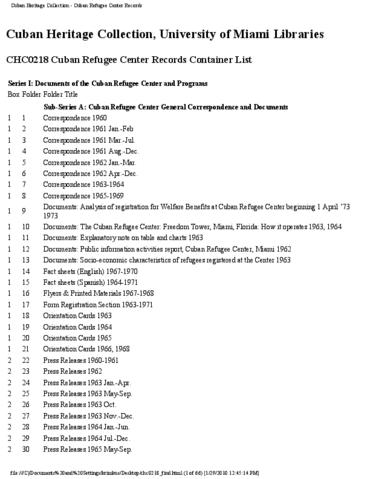Zone d'identification
Nom et localisation du dépôt
Niveau de description
Collection
Titre
Cuban Refugee Center Records
Date(s)
- 1960-1994 (Production)
Importance matérielle
109 Boxes
Nom du producteur
Histoire administrative
The Cuban Refugee Program was authorized by the President of the United States in February 1961. Federal assistance for Cuban refugees had begun in 1960 under President Eisenhower in response to the growing number of Cubans fleeing the Castro regime. President John F. Kennedy, recognizing that the situation was beyond the scope of individual states and volunteer agencies, assigned responsibility to the Secretary of Health, Education and Welfare (HEW), at the time Abraham Ribicoff, who delegated implementation and administration to William L. Mitchell, Commissioner of Social Security. The “Migration and Refugee Assistance Act,” enacted in 1962, provided the legislative basis for the program and authorized appropriations. The Florida State Department of Public Welfare, representing the federal government, set up an office in Miami for the assistance, child welfare services and medical care of Cuban refugees.
The Miami Cuban Refugee Emergency Center, located at the Freedom Tower, 600 Biscayne Boulevard, became the focal point of refugee registration, assistance, relief and resettlement, as well as coordination of government and independent agencies’ programs. Federal funding provided for the center’s operations, record keeping, publications, coordination of agencies and research on different aspects of the refugee situation, as well as for programs. The latter included financial assistance, educational loans, health care, adult education and re-training, resettlement and care of unaccompanied children. By 1962 between 1500 and 2000 Cubans were arriving weekly.
In 1963 the newly formed Welfare Administration succeeded Social Security in overseeing the Cuban Refugee Program. The decrease in influx of refugees following the cessation of regular flights and the implementation of programs such as home visits facilitated the transition from crisis response to a more efficient, better organized program.
In the years to come, however, the program would have to adapt to new emergency situations such as the arrival of Bay of Pigs Brigade 2506 prisoners in 1963 and the Camarioca boatlift of 1965. Perhaps the most taxing year was 1980 when the Mariel boatlift brought more than 125,000 Cubans to the United States. Simultaneously, Haitian refugees had started to arrive in growing numbers. The federal government declared a state of emergency and charged the Federal Emergency Management Agency (FEMA) with processing and assisting the entrants. On July of the same year the Cuban-Haitian Task Force (CHTF) was created to coordinate federal resources in support of county and state efforts, and to address community problems related to the influx of refugees into the Miami area, replacing FEMA in this capacity.
The Center closed its last location on Ponce de Leon Boulevard and 8th Street on July 1994, after more than three decades of providing assistance to thousands of refugees. Its archives were donated to Professor Juan Clark of Miami-Dade College who in turn donated them to the Cuban Heritage Collection.
Zone du contenu et de la structure
Portée et contenu
The Cuban Refugee Center Records include correspondence, reports, publications, photographs, and clippings created and collected by the Cuban Refugee Center (CRC), in Miami in 1960 as part of a federal program to assist Cubans arriving at the United States as political refugees.
Mode de classement
The Cuban Refugee Center Records are organized into seven series.
Please refer to the Finding Aid/Inventory section for more information about the organization of this collection.
Zone des conditions d'accès et d'utilisation
Conditions d'accès
This collection is open for research. Box 108 contains confidential documents from the collection and has been restricted.
Accès physique
Accès technique
Conditions de reproduction
Requests to publish or display materials from this collection require written permission from the rights owner. Please, contact chc@miami.edu for more information.
Preferred citation: Cuban Refugee Center Records, Cuban Heritage Collection, University of Miami Libraries, Coral Gables, Florida.
Langue des documents
- anglais
- espagnol
Écriture des documents
Notes de langue et graphie
Instruments de recherche
Générer l'instrument de recherche
Éléments d'acquisition et d'évaluation
Historique de la conservation
Source immédiate d'acquisition
Gift of Juan M. Clark
Évaluation, élimination et calendrier de conservation
Accroissements
Sources complémentaires
Existence et lieu de conservation des originaux
Existence et lieu de conservation des copies
Selected materials from this collection have been digitized.
https://digitalcollections.library.miami.edu/digital/collection/chc0218
Sources complémentaires
Descriptions associées
Élément de notes
Notes spécialisées
Identifiant(s) alternatif(s)
Zone du contrôle de la description
Règles ou conventions
Sources utilisées
Note de l'archiviste
Processed by Isabel Ezquerra, Ximena Valdivia, and Duvy Argandoña, 2007. Retrospectively converted from HTML to EAD XML September, 2008 by Lyn MacCorkle and Kyle Rimkus based on a crosswalk by María Estorino. Updated by Juan A. Villanueva, March 2016. Date revised by Amanda Moreno, February 2018. Updated by Rebeca Gonzalez, May 2021.
Mots-clés
Mots-clés - Sujets
Mots-clés - Lieux
Mots-clés - Noms
- Cuban Refugee Center (Sujet)

